Empowering Citizen Developers | Ultimate Guide
IT teams have never been busier. Combine increasing demand for custom solutions with a global shortage of qualified developers, and it’s no wonder that delays, roadblocks, and backlogs occur. One solution is creating an army of citizen developers.
And it’s becoming a more and more popular solution too.
Despite this, relying on citizen developers isn’t always plain sailing. When done right, this can offer huge financial, cultural, and operational benefits. When done wrong, you’ll encounter unnecessary risks, mistakes, and costs.
So, it’s crucial to have the right strategy, tools, and controls in place to gain maximum benefits from any citizen development initiative.
Today, we’re diving deep into everything you need to know to achieve this.
Specifically, we’ll look at the role of citizen development, its pros and cons, and the practical steps you need to take to empower your team to solve their own problems with technology.
But first, let’s take a look at the basics.
What is a citizen developer?
A citizen developer is a non-technical employee who can build their own solutions to everyday business problems. So, despite not being a developer per se, they’re empowered to create custom tools for themselves and their teams.
However, there are a couple of other things to keep in mind here.
An employee who takes it on themselves to start building software without telling anyone wouldn’t quite fit the bill. Instead, citizen developers should be sanctioned and encouraged by their companies. This normally involves an official program of one kind or another.
The idea isn’t to simply let your employees loose to do whatever they want. Instead, citizen developers should work within a relatively narrow framework, including:
- Using approved tools.
- Following set procedures for monitoring, oversight, and information sharing.
- Adhering to security protocols.
- Clear delineation and scope.
- Asset sharing.
- Other IT governance measures.
For example, if one of your sales colleagues decided they didn’t like your CRM and built their own alternative, this wouldn’t fall under the citizen developer umbrella, by any stretch of the imagination.
This should perhaps go without saying, but citizen developers also need to be good-faith actors. That is, they act within the rules to try and improve internal processes, rather than subvert them, cut corners, or just make their own lives easier.
Check out our ultimate guide to traditional SDLC vs RAD .
Where do citizen developers fit into your IT strategy?
The core task of your IT department is ensuring that all other teams have the tools they need to do their jobs effectively. The trouble is that they’re limited by the resources they have available to them.
That is, even in the largest enterprises, there’s still a finite amount of money, development time, and other resources available to the IT team.
By extension, the IT department is also responsible for controlling how and when employees interact with different resources, along with preventing unauthorized access. A big part of this is maintaining a set of approved tools and vendors.
You can probably already see the issue here.
What happens when your IT team doesn’t have the resources to build or procure suitable tools quickly enough?
There are a few possibilities:
- Your employees are forced to go without appropriate tools.
- You continue to use dated tools past the end of their shelf-life.
- Your employees build their own solutions that IT has no control over.
Obviously, you don’t want any of these situations to occur. Each of them leads to unnecessary risk, avoidable costs, and poor transparency.
But as we know, there are only so many hours in the day. Leveraging citizen developers is one way to square this circle.
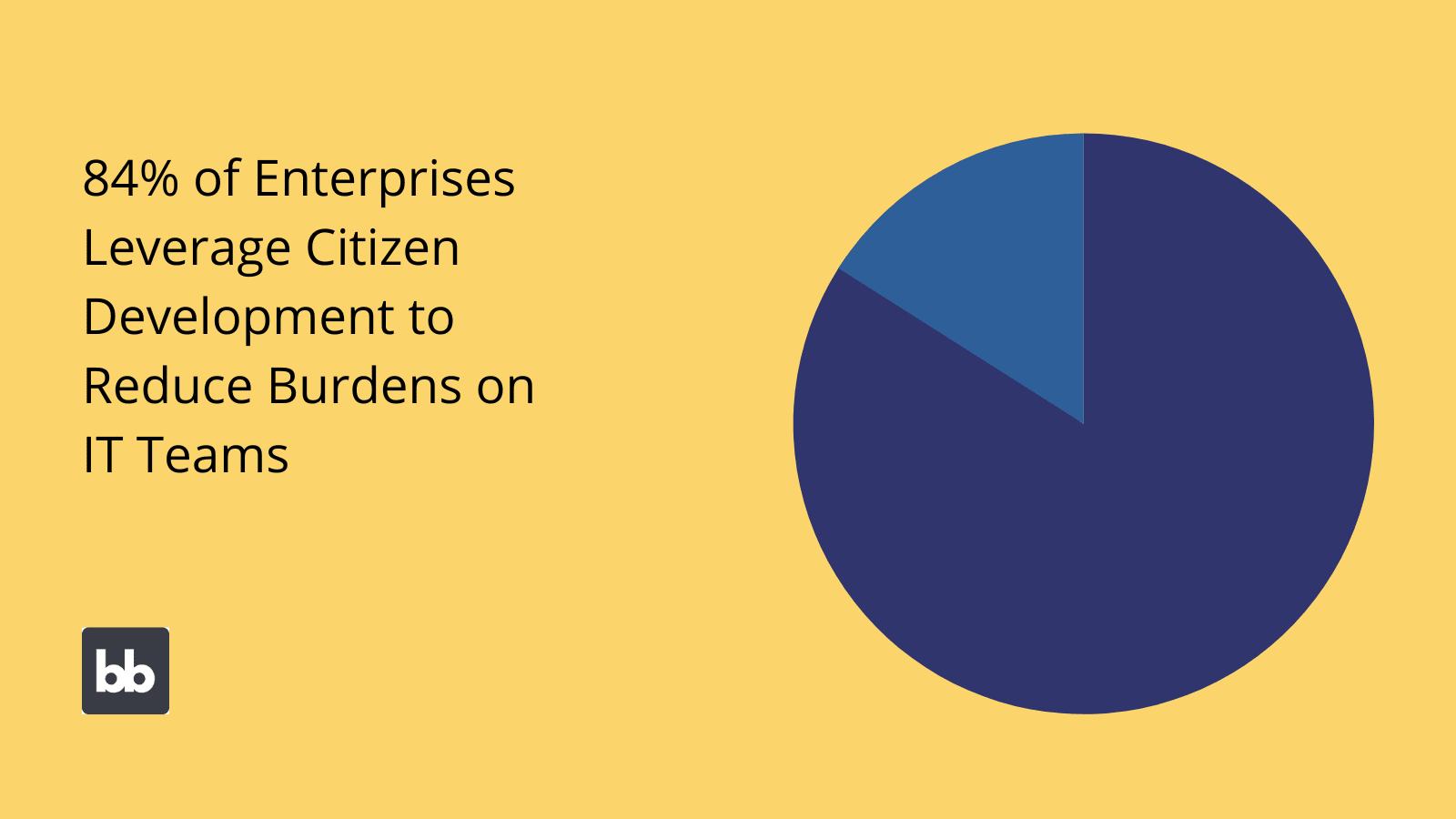
(G2 )
Why do businesses need citizen developers?
So what can you actually achieve with citizen developers? Or, more concretely, why is this an increasingly popular option for supporting busy IT teams?
Check out our standalone guide to citizen development.
Let’s take a look at some of the core reasons that a growing number of businesses are turning to citizen developers to fill their IT needs.
Quick turnarounds
The most obvious reason to encourage citizen developers is to minimize delays when it comes time to build new solutions. This relates to the core problem we saw earlier. That is, overstretched development teams lead to delays.
It’s worth thinking about how this impacts your business besides the fact of the delay itself.
Specifically, your team won’t have the tools they need, so their ability to carry out tasks quickly, accurately, and effectively also suffers. And then you’ll start losing money, either through poor outcomes or increased costs.
Citizen developers help to prevent backlogs in two ways:
- Directing simple development tasks away from your in-house devs.
- Spreading development tasks across the most relevant teams.
Commercial awareness
Another reason to leverage citizen developers is to bridge the gap between technical expertise and commercial awareness.
The key thing here is that your non-IT employees will generally have a much deeper understanding of the business problems that different tools will solve.
At least, they’re coming at it from a different angle.
So, let’s say your after-sales team needed a new tool for managing escalations. On-the-ground colleagues will always have a much firmer grasp of the kinds of problems that their colleagues and customers face on a daily basis.
Therefore, they’ll also be better positioned to operationalize the kinds of processes, taxonomies, and follow-on actions that are required in any given situation.

(Poszytek.EU )
Fostering innovation
Citizen developers are non-technical colleagues who you’ve empowered to solve problems for themselves.
This goes hand in hand with fostering innovation across your business.
When your employees can quickly and easily create solutions to their own problems, it’s much more likely that they’ll try out novel new ideas.
From an operational point of view, this also lowers the wider costs of innovation.
For example, we can avoid using up more expensive internal development hours on unproven solutions. We’ll also save on hidden development costs, including communication and project management time around building internal solutions.
Take a look at our guide to integrating multiple databases .
Governing shadow IT
Shadow IT is a catch-all term for any tools your employees use outside of your official, approved hardware and software stacks. This could be:
- Plugins for approved tools.
- Standalone tools.
- SaaS subscriptions.
- Custom apps.
- Personal devices.
- Free tools or free trials.
To some extent, shadow IT is a fact of life. Some employees will always turn to uncontrolled tools to complete their daily tasks. Indeed, whether this is actually a problem or not is a subject for debate that we won’t get into.
The key thing for our purposes though is that empowering citizen developers helps you to bring shadow IT under your control.
That is, the citizen developer approach recognizes that there’s huge value in empowering employees to solve problems for themselves. Instead of preventing innovation, the goal is to provide tools to enable this, without undermining your IT team’s other priorities.

(CISCO )
Check out our in-depth guide to citizen development governance .
Eliminating silos
Finally, citizen developers are highly focused on collaboration. In large organizations, there’s often a big disconnect between the IT department and end-users. As you might expect, this leads to imperfect solutions.
This is particularly common when tools are provided from above, with minimal input from ground-level users.
Citizen development offers a more effective alternative. Depending on the processes you build out, this can work in a couple of different ways:
- Providing greater project ownership to end users.
- Allowing greater collaboration between technical and non-technical teams.
On the second point, you might put processes in place to allow end users to create early iterations of their own solutions, before passing them to IT to finalize specific aspects of their configuration and security.
Citizen development: pros, cons & challenges
So far, we’ve explored some of the reasons why you might turn to citizen developers. However, it’s important to note that this doesn’t mean this is invariably the right approach for every business.
Instead, you need to know the specific factors you should consider to make an informed decision, based on your own requirements.
With that in mind, let’s weigh up the pros, cons, and challenges you can expect from citizen developers.
Pros
We’ve touched on a lot of this already, so we can just summarize for now. We know that businesses turn to citizen developers to help make the most out of limited resources within their IT team.
So is it only ever a case of necessity?
No, bluntly. If you had unlimited IT resources, you might still encourage citizen development, because it offers high levels of:
- Efficiency.
- Process mapping.
- Return on investment.
- Employee engagement.
- Expediency.
However, as we’ll see in a second, this isn’t inevitably the experience you’ll have. Instead, this is contingent on a number of factors. For example, your employees will obviously need a certain level of technical competence to be effective citizen developers.
We’ll return to some more barriers when we look at associated challenges shortly.
Cons
But first, what are the downsides here?
The existence of professional developers is a strong indicator that enabling non-technical staff to build their own solutions isn’t always the right approach.
So where do citizen developers fall short of their specialist counterparts?
Maybe this goes without saying, but technical abilities are a big consideration here. Citizen developers rely on specific platforms to build tools. While these are better than ever, there are still limitations to what you can build with specific packages.
We’ll return to this a little later when we talk software stacks.
Another potential downside is that you’ll likely need to provide support for a greater number of tools. This will need to be accounted for, either by the IT team or internally within the relevant departments.
In either case, you’ll need to weigh up the associated costs.
Finally, you’ll need to think about how you resource and support your citizen developers. Specifically, it’s unlikely that they’ll use the same tools as your full-time devs. So, you’ll need to procure a suitable platform.
So, it’s important to shop around. Again, we’ll return to this when we come to look at how Budibase supports citizen developers.
Challenges
Let’s turn our attention to some of the other challenges you’re likely to encounter, along with the kinds of measures you’ll need to overcome them.
That is, there are a bunch of non-technical factors that determine how effectively your citizen developers operate.
Let’s take a look at some of the most important ones.
Quality control
One of the most common stumbling blocks is quality control. The basic issue here is that citizen developers’ outputs might not have the same consistency or quality as you’d expect from your specialists.
This has an impact at two key levels:
- The level of functionality that citizen developers can achieve.
- The likelihood of bugs, service interruptions, or other errors.
So, we’ll need to put measures in place to mitigate these issues. Specifically, we can use a combination of the following:
- Implementing appropriate vetting/approval processes.
- Assigning and upskilling champions within teams.
- Choosing the right software stack for your citizen developers.
In other words, we need to effectively control how our employees build tools and whether or not these can be rolled out.
Compliance & security
Security is another big stumbling block. Building secure tools that comply with relevant legislation is a specialism in itself. We can’t reasonably expect non-technical colleagues to be experts here.
All the same, we obviously can’t compromise on security and compliance.
So what can we do?
The challenge here is empowering citizen developers without undermining your compliance efforts or creating unnecessary risks. Of course, your choice of approved platforms plays a huge role here.
Besides this, we have a few options, including:
- Delineating responsibilities - For instance, allowing citizen developers to create basic designs and functionality, but leaving more advanced configuration to specialists.
- Templating key security features - For example, by using global settings and configuration across your custom tools, SSO, and other techniques.
- Hosting & deployment-level measures - Deploying new tools locally and implementing security controls on your own infrastructure.
Naturally, if you want to opt for any of these strategies, you’ll need to choose an app-building platform that supports them. We’ll return to this shortly when we come to look at what Budibase offers for citizen developers.
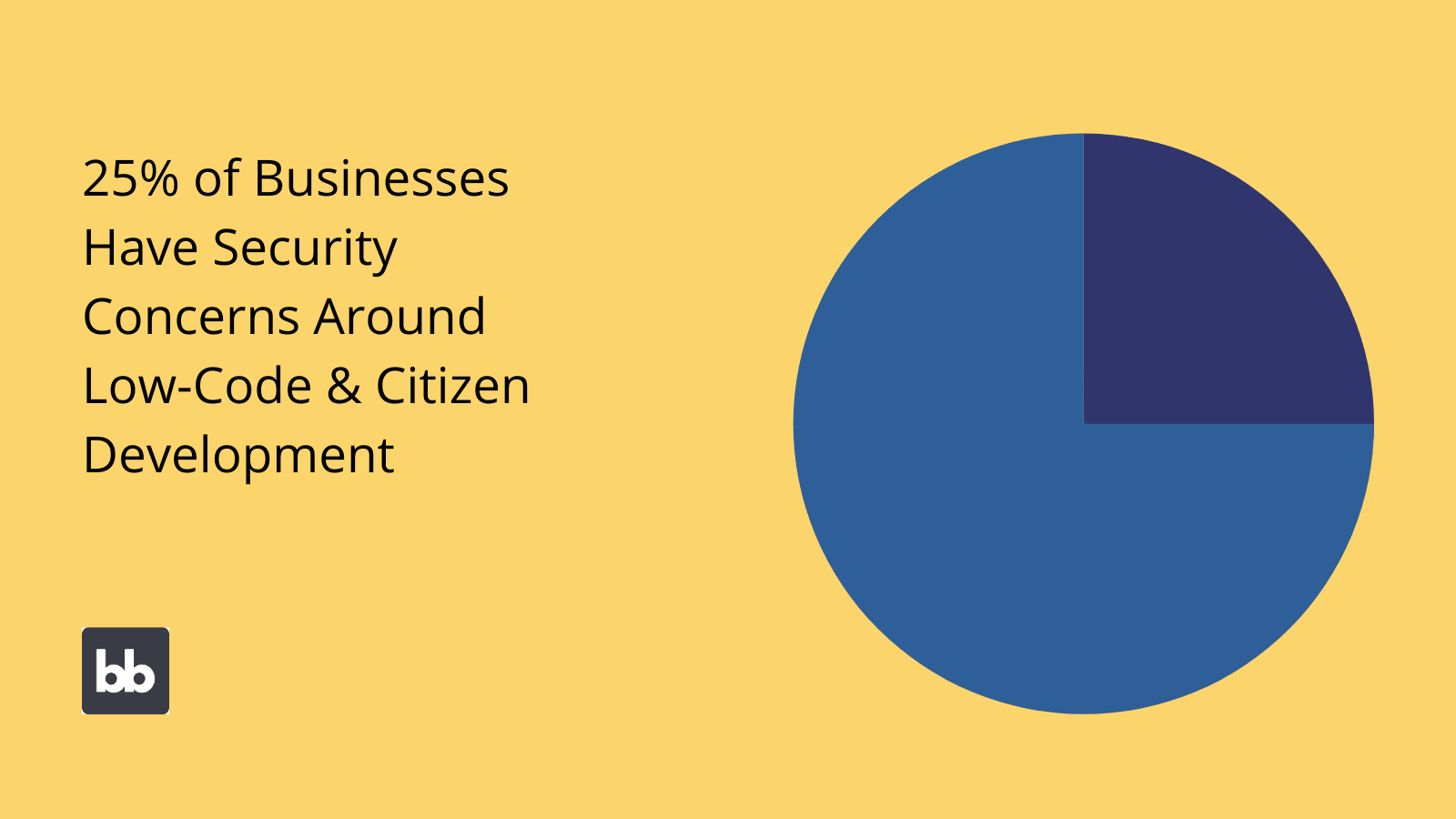
(G2 )
Support and maintenance
Supporting and maintaining citizen developers’ creations also poses some unique challenges.
Specifically:
- The original developer and responsible support staff might be from completely different teams.
- These tools might fall outside of established design patterns and best practices.
- Citizen developers have other responsibilities and are unlikely to have time to monitor issues or tickets.
- Citizen developments might be more prone to bugs if the quality control issues above aren’t addressed properly.
Your best option here depends on a range of factors, including your current support resources, the number, variety, and complexity of tools you expect to output, volumes of end-users, and your existing support processes.
As such, it’s hard to generalize.
The key thing, therefore, is to design processes that maximize the coverage and level of support you can offer to end-users while minimizing the costs incurred.
Documentation
Citizen developers also tend to struggle with documentation. This makes life difficult for end-users, as well as anyone who’s tasked with maintaining tools down the line. So, when we talk about documentation, we really mean two things:
- Creating resources around how a tool is intended to be used.
- Recording the rationale behind different design and development decisions.
A huge part of the problem here is that non-technical staff often don’t know exactly what needs to be documented and what doesn’t. For example, if they’re unaware of alternative ways of achieving a given functionality.
Robust training and guidelines are your best defense against documentation issues.
That is, the only surefire way to bridge the gap between what your documentation needs and what your users actually provide is to set clear expectations.
There are a few other steps we can take to support these efforts.
One is limiting the degree of discretion given to citizen developers in the first place.
That’s not to say that we want to stamp out innovation. Rather, we can make our citizen developers’ lives easier by providing reusable components, themes, functions, templates, and configuration tools.
How to build a citizen developer program in 9 steps
You’ve made it this far, so let’s assume you’re convinced by the whole idea of leveraging citizen developers.
The next step is designing the specific framework that your employees will work within.
For now, we’re only concerned with defining the right processes. We’ll discuss the more technical side of things a little bit later.
With that in mind, here are the steps you can follow to build a killer citizen development program.
1. Set your goals
As with any new initiative, we need to start out by defining exactly what we want to achieve. We already know the high-level goal here - to free up our developers’ time by empowering non-technical staff to solve their own problems.
But, sadly, this isn’t quite specific enough.
You see, we need quantifiable goals that we can measure our success against. For our purposes today, there are two obvious metrics we can pay attention to:
- Development hours.
- Associated labor costs.
These are essentially two sides of the same coin.
Or, you might have slightly different priorities. Maybe you’re more concerned about your turnaround times than development costs.
In this case, you’d set targets around the average lead time between initial ideation and deployment of different tools. Or, in very large organizations, you might even set your goals based on the total output of tools in a given month.
In any case, the point of this exercise is to define the business value that we’re going to provide. Naturally, this then informs all of our subsequent decisions.
2. Define the scope of your program
Next, it’s time to think about scope. We mean three separate things by this:
- The number and variety of employees who will take part.
- The kinds of tools they’ll build.
- The user bases of these tools.
Let’s think about each one in turn.
The first is basically a question of who your citizen developers will be and how you’ll select them. So, you might cast a wide net by allowing anyone to build tools, or you might opt for a small number of designated developers across your team.
Then, you’ll need to think about the kinds of solutions you want your citizen developers to work on. So, will they have free reign or will they be limited to a smaller subset of simple tools, like CRUD apps?
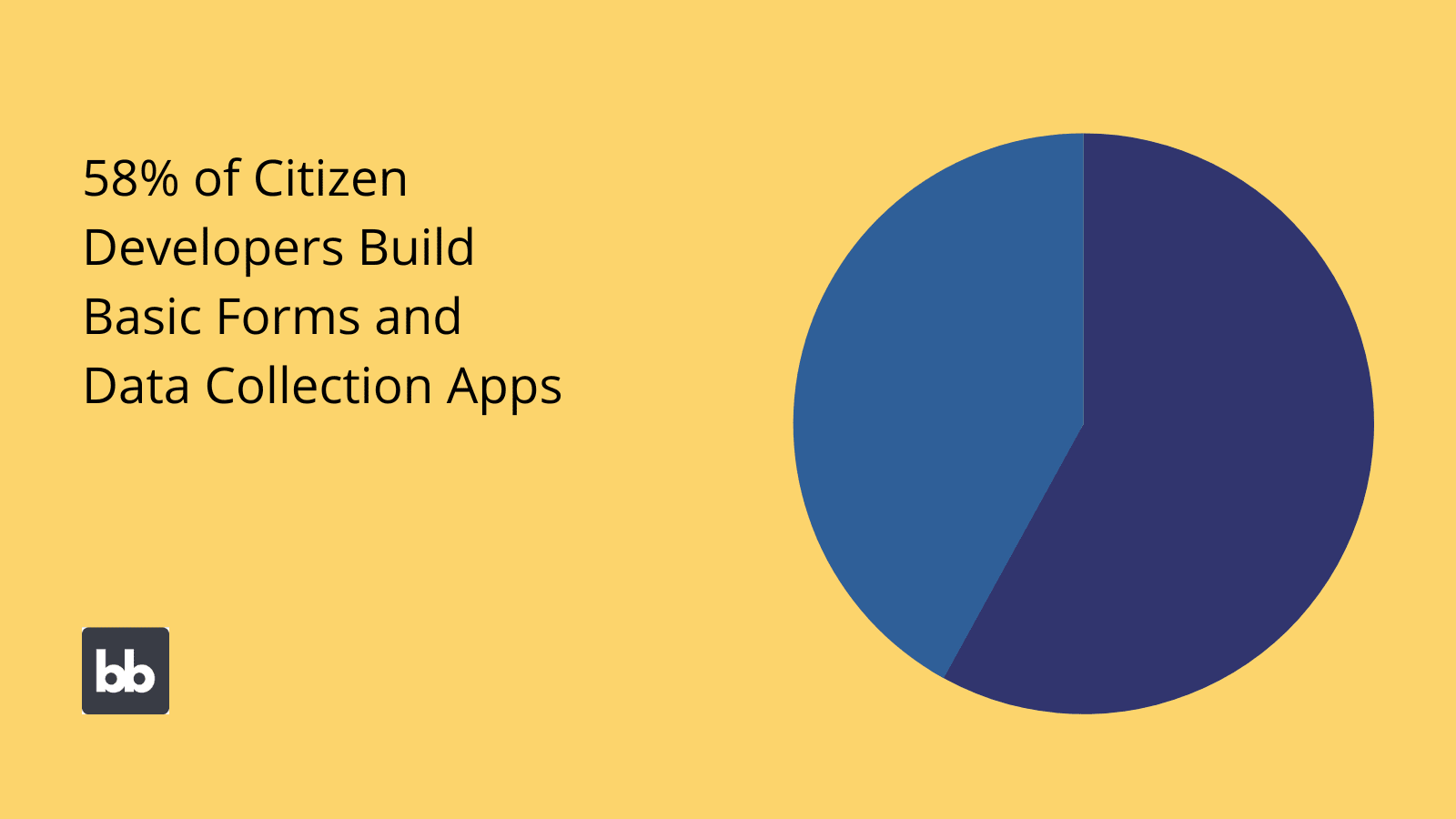
(Gartner )
Finally, how widely do you expect your developers’ output to be rolled out? Will they be exclusively for their own use, for their immediate colleagues, or for a wider user base, like customers and clients?
Each of these will inform later decisions, especially around your software stack. For example, if you’re anticipating a large number of diverse users, you’ll likely need more advanced security tools, like role-based access control .
3. Get stakeholders involved
You’re also going to need buy-in, both from ground-level employees and higher-ups.
In both cases, the challenge is gaining recognition of your core business problem and convincing stakeholders that citizen developers are the best solution. Unfortunately, the similarities end here.
That is, your CTO and your would-be citizen developers are inevitably going to have very different concerns.
In some ways, securing buy-in from your leadership team is actually more straightforward. That is, their focus is always going to be what’s best for the business’s bottom line, as long as other priorities like risk and security aren’t compromised.
With your on-the-ground team, concerns are likely to be a lot more varied.
The key thing to focus on, though, is how your program is going to make their lives easier. For example, by reducing delays when it comes to rolling out mission-critical apps.
4. Choose your tools
With buy-in secured and a clear idea of your scope, you can start thinking about the specific tools you want your citizen developers to use. For good or for bad, you have more options here than ever before.
We’ll have a fuller discussion of how to build a software stack for citizen developers shortly, so we’ll just make a few high-level points for now.
In almost every case, your best bet is going to fall under the no/low-code umbrella.
If you don’t know what this means, you can check out our guide to open-source, low-code platforms .
You might, fairly reasonably, be skeptical about these kinds of tools. At least, if your only experience with low-code development was any more than a few years ago, you could be forgiven for having a somewhat low opinion.
But, the landscape is very different today.
Gone are the days of unwieldy, grey, inflexible app-builders. Instead, modern platforms offer incredible versatility, usability, and expediency. As we’ll see a little later, Budibase is leading the pack.
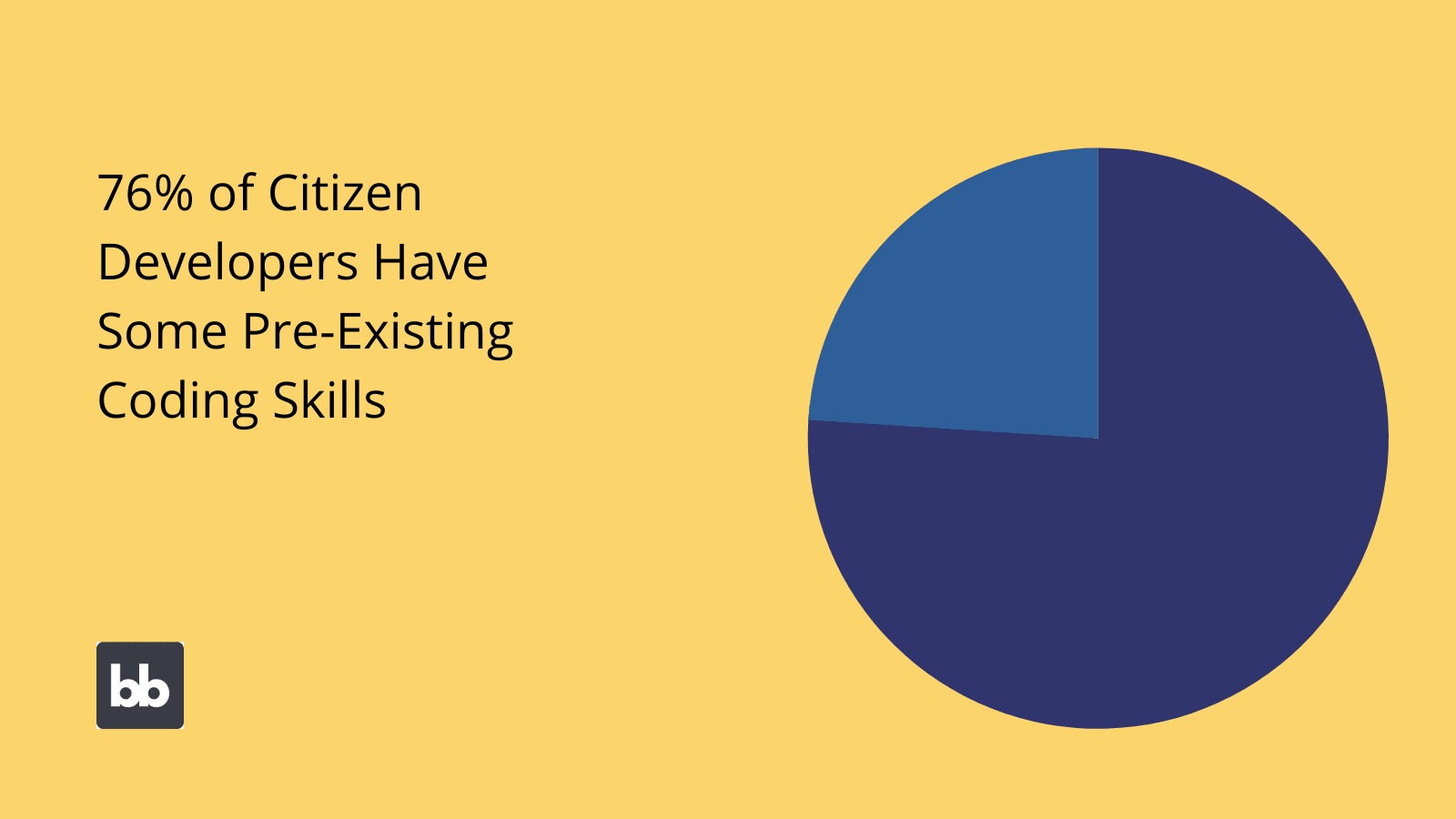
(ImpacyMyBiz )
Check out our guide to choosing citizen developer tools .
5. Identify your training needs
Next, we need to think about how we’re going to turn our non-technical staff into citizen developers. To start with, we can ask ourselves three questions:
- What is our team’s current skill level?
- What is the required skill level?
- What actions do we need to take to bridge this gap?
This is a critical step.
There are a few different ways that we can assess the current aptitude of our potential developers. One is to consider the requirements of their present role and any digital skills that come along with this.
For example, if employees regularly perform complex numerical tasks, they might find it easier to upskill to building apps. Similarly, some job roles will require existing design or media editing skills, which will give employees a head start.
Alternatively, we can take our cues from the kinds of tools employees currently use.
One thing to look out for is whether employees are already different kinds of automation tools. This is more common than you might think. Spreadsheets are one obvious example. Or, they might use native automation functions within SaaS tools.
This helps us to figure out if we need to treat our employees as complete beginners or if they have a base-level understanding of key concepts already.
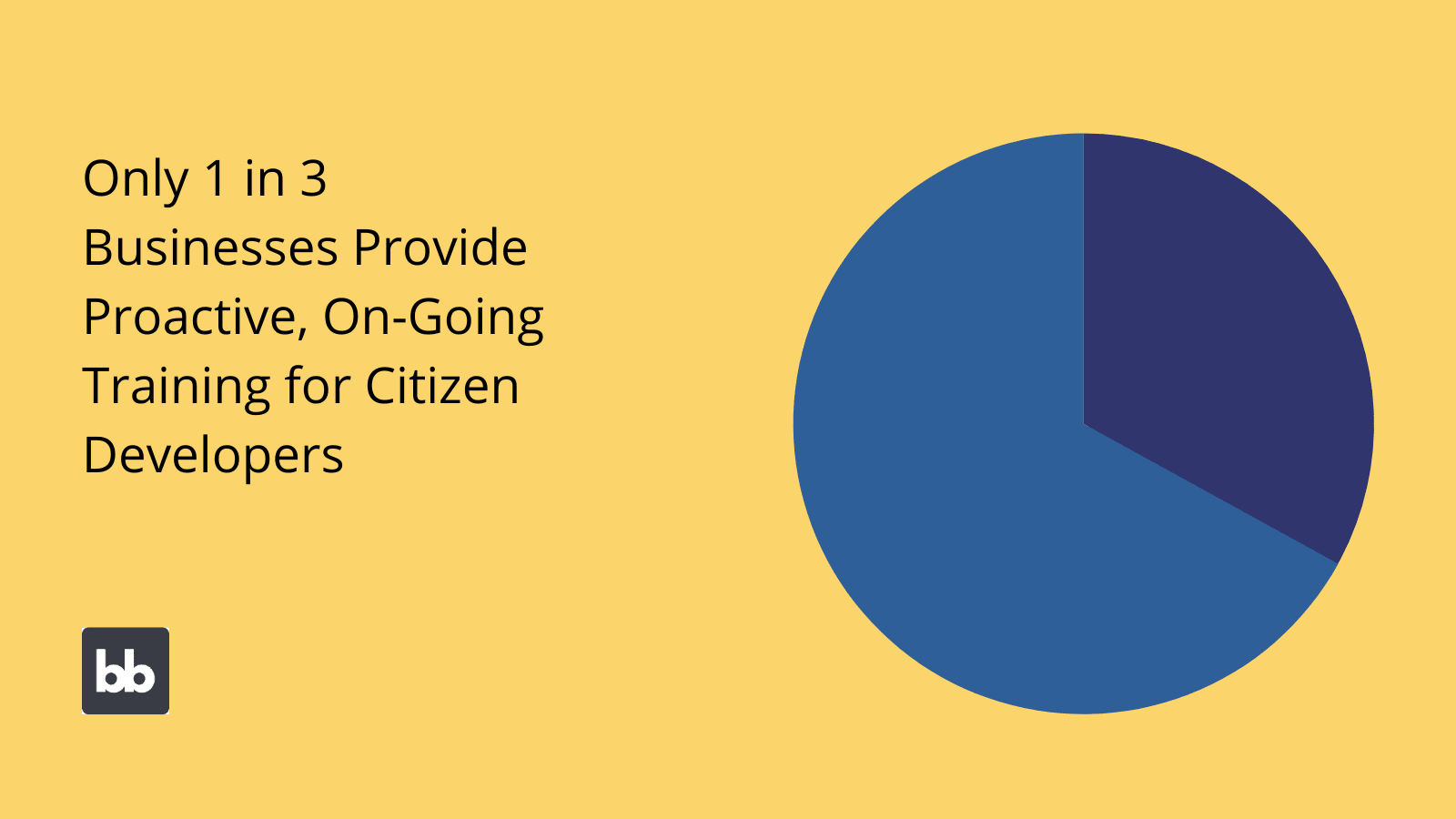
6. Design review, vetting & approval processes
We’ll also need to build out processes to govern how new tools are built, approved, and rolled out.
To a large extent, this will be informed by the scope of your program. So, if you place strong limits on the kinds of tools employees can build, approval should be simpler, at least in theory.
Similarly, if you opt for a smaller number of more highly skilled citizen developers, your processes will look different than if you have a more open field.
In any case, there are a couple of specific things you’ll need to build into your processes. For one, what specific steps will citizen developers need to bring their tools from initial ideation to realization?
Will someone need to sign off on the initial idea or can they go ahead and build tools on their own initiative? Will there be any final sign-off processes before they can roll these tools out?
These are all questions we’ll need to answer before we can set rules, boundaries, and workflows for our citizen developers.
This is particularly important, as there can often be competing concerns that citizen developers don’t fully appreciate.
For instance, non-specialists will almost always prioritize usability and process mapping over security, or more technical concerns like stability and performance. They’re always going to focus on what they know and understand.
The trick is to harness the efficiency benefits that this brings, while also making sure that other important concerns aren’t undermined.
7. Identify additional resources
You’ll also need to account for indirect costs. This is comparatively tricky. With things like tools and training time, it’s easy to put a dollar figure on what resources you need to allocate. Sadly, this isn’t the full picture.
So what kind of additional resources might your citizen developers need?
There are two big categories that we need to be aware of:
- Technical resources - Any additional platforms, hardware, infrastructure, or other resources needed to get your new tools rolled out.
- Operational resources - Especially additional labor costs, including approvals, support, maintenance, and administrative time.
Hidden costs can ruin any transformation project. For example, there isn’t much point in trying to save your developers time and then creating processes that create a whole raft of admin work for them.
Similarly, as you roll out your citizen developers’ output, you might encounter the need for extra technical resources. This could be anything from hosting to design tools. Without fully accounting for this, it’s easy to miscalculate your ROI.
There are other indirect costs that we can think about too.
These include things like risk, error correction, employee push-back, all manner of other operational and organizational issues.
8. Select and train citizen developers
So, we know the kinds of employees we want to target, what our training program will look like, and the processes our prospective developers are going to follow. It’s time to start selecting and upskilling employees.
Of course, there’s no one-size-fits-all approach here.
Let’s take selection first.
As far as possible, this should be voluntary. That is, it’s best to choose employees who actually want to be citizen developers. Obviously, this will lead to better motivation both for upskilling and actually building tools.
There’s inevitably going to be a degree of compromise needed here though. After all, you’ll need to balance what your employees want with what the business needs.
We’ll also need to think about the specific ways we’ll upskill our employees. There is a whole range of different issues to consider here.
One is your choice of tools. Do these require specific training? Does the vendor offer a dedicated training program if so?
You should also think about your team. Are they more suited to self-directed learning or do they need a specific syllabus? Will you put any measures in place to test their knowledge before they’re approved as citizen developers?
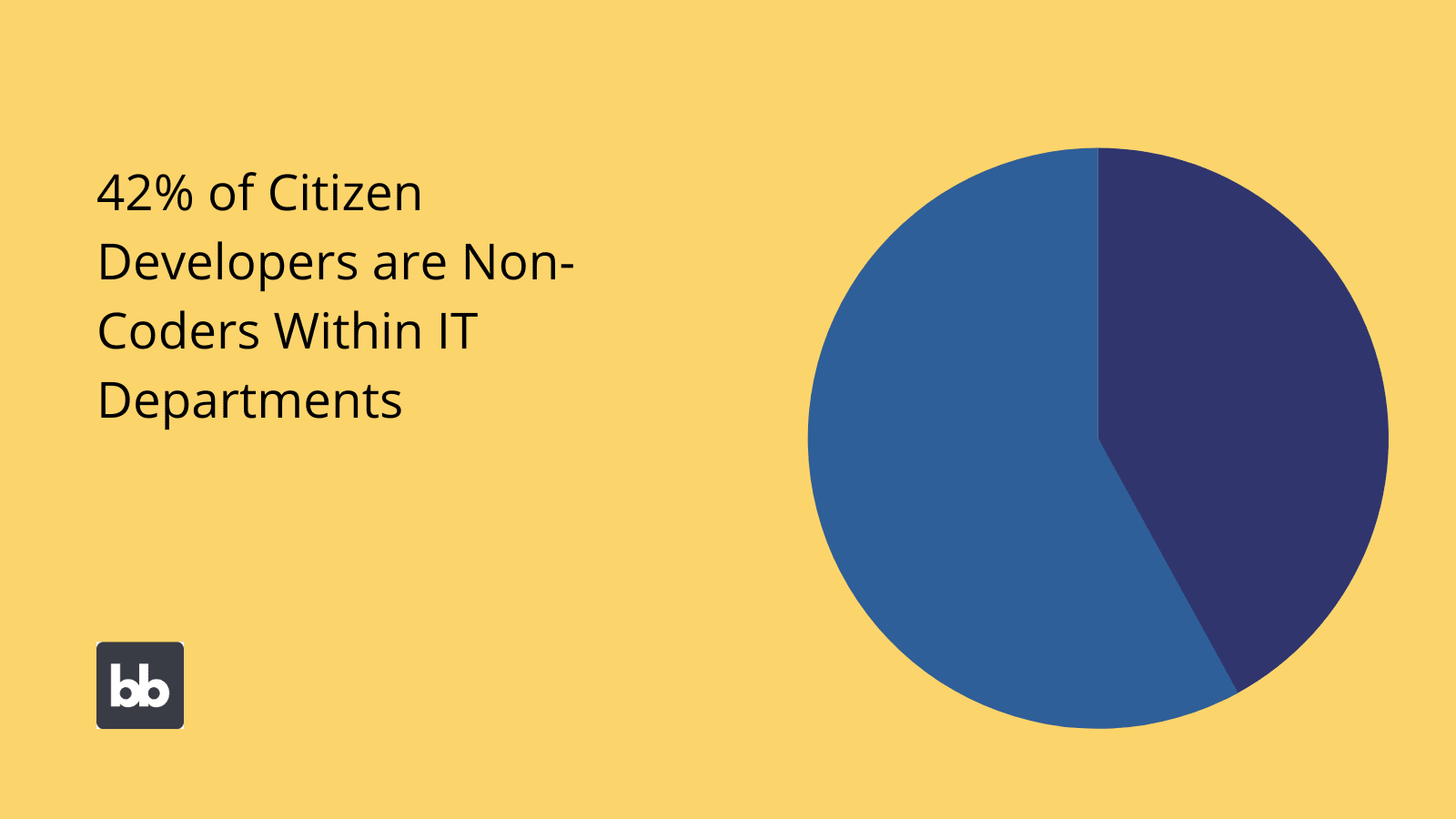
9. Monitoring, auditing, and continuous improvement
Finally, we’ll need to build processes that allow us to monitor and audit our developers’ output. The trouble is that we need to do this at a few different levels. There’s the quality of the tools themselves, on the one hand, and process adherence and ROI on the other.
In other words, we want to keep an eye on how our citizen developers are building tools, as well as how effective these are. Are they actually delivering value?
Your original goals are essential here.
Really, the point here is determining exactly how we’re progressing towards our goals. This allows us to do two things:
- If we’re falling short, we can identify the specific reasons why.
- If we’re achieving our goals, we can seek out improvement opportunities that we might not have initially spotted.
This is called continuous improvement. Let’s take an example.
Say we discovered that our citizen developers were succeeding in creating effective tools and we’re satisfied that we’re saving on labor costs, but we haven’t materially improved turnaround times.
So, we’re meeting some of our goals but failing on others. The approach here would be to identify specific areas where delays are occurring. Are projects getting held up at the approval stage or are our citizen developers just slower than we anticipated?
Alternatively, maybe your team is churning out tools quickly, but the apps themselves aren’t up to scratch. Most of the time, this will mean rethinking your software stack. We’ll return to this in a second.
In any case, the key here is determining what your strengths and weaknesses are.
That way, you can decide where you need to change tact, provide extra training, try new tools, or allocate additional resources.
Building a software stack for citizen developers
With the process-level stuff out of the way, we can turn our attention to choosing the right tools to equip our citizen developers with. As we’ve hinted at already, this has a huge impact on how successful your program ultimately is.
So, it pays to get it right the first time around.
Luckily, there are only a few points you need to nail. These fall into two categories:
- Tools used by citizen developers to build apps.
- Tools used by your IT team to manage citizen developers and their output.
Here are the key things you’ll need for each.
No/low-code tools
Most citizen developers use platforms that fall under the no-code/low-code umbrella. These are platforms that specifically aim to empower non-developers to build applications. This style of development has exploded in popularity over the past few years.
Only, low-code tools aren’t all made equal. In fact, there’s a huge disparity between different platforms, in terms of quality, flexibility, usability, functionality, security, pricing, and just about every other variable you can think of.
As such, this is probably the most important decision you’ll make.
So, how do you tell which is the right platform for your citizen developers?
One good jumping-off point is the kinds of tools you expect to build. Some platforms are more closely tailored to one type of app or another.
Most of the time though, you’ll need to dig quite a bit deeper. Specifically, you need to assess potential options against your requirements, especially concerning recurring costs, supported features, user experiences, and configuration options for finished tools.
For example, you might know in advance that you need to do something specific, like implement RBAC across all of your tools or integrate with particular external tools. Obviously, you’d want to know this is possible before you sign up for a low-code platform.
We also need to think about less cut-and-dry issues. Not least of all, how your users feel about different tools. That is, do they find them intuitive, usable, and efficient? Can they immediately recognize how to take different actions without explicitly being shown?
In other words, can they use specific tools? Do they enjoy using them?
This might seem silly, but how your users experience different platforms will have a material impact on the success of your citizen development program. Obviously, you’ll get more out of your team when they actually enjoy what they do.
Approvals and workflow management
One of the most common stumbling when trying to eek ROI out of citizen developers is the hidden costs that come along with related internal processes. So, we’ll often also need specific tools to manage citizen development workflows, from ideation to deployment.
Normally, the idea here would be to try to replicate existing workflows. But, in this case, there’s a good chance you’re building workflows from scratch.
Either way, the idea here is to create the most efficient route from initial inspiration to fully fledged application, without undermining any checks or vetting processes that you need to carry out.
Approval apps are some of the most basic tools for managing internal workflows.
Basically, these allow one group of users to submit a certain type of request. This can then be approved or declined, either by another group of users or programmatically.
So, you might use an approval tool for citizen developers to get final sign-off to roll out their tools.
Check out our approval apps page for more information.
Hosting and deployment
We’re bending the definition of software stack a little bit here, but we also need to mention to tools you use to deploy and host applications. This feeds your apps’ security, accessibility, technical performance, and more.
We don’t normally want our citizen developers to have a say here as such.
Rather, we’ll need to have the right solution in place to allow our team to quickly and easily publish tools for their colleagues. The builders and users themselves don’t necessarily need to understand what’s going on under the hood.
Broadly, you’ve got a few different options:
- Public cloud.
- Private cloud.
- Deploying on a local network.
- Local deployment on a single device.
- Hybrid solutions.
The right choice is highly contingent. At least, different options offer clear pros and cons. For example, public cloud deployments make it easy for users to access your tools from anywhere, on any device.
Whether this is a good thing or a bad thing depends on your specific requirements.
Self-hosting, either locally or on a private cloud, offers a much greater degree of flexibility, and security. However, this also brings extra costs, maintenance needs, and other responsibilities. We’ll look at how Budibase stacks up for hosting and deployment a little later.
Visual assets and design
Sadly, we can’t really expect our citizen developers to also become expert designers. There are only so many hours in the day. So, we need to do what we can to make their lives easier. There are a couple of different levels to this.
One is app UI design . In other words, the interfaces that your team builds for users to interact with their apps.
Of course, this is vital. To a large extent, though, it’s determined by your choice of development tool, so you often won’t need extra platforms. There are a few additional strategies you can turn to nonetheless.
For example, by providing global themes, templates, brand elements, and other visual assets within your development tools to speed up the design process.
It’s also worth thinking about what happens if your citizen developers ever need custom assets. Say, a header image for example. If you’re not careful, you could accidentally create a lot of extra work for your graphic designers.
So, you might opt to provide user-friendly image editing tools, a request app for design work, or other tools to manage related workflows.
Monitoring, feedback, and oversight
Remember that one of the core goals of citizen development is improving the governance and oversight of shadow IT. So, your IT team needs a clear picture of what’s going on. This includes how different tools are being used and by whom.
This can vary from simple user volumes across various tools to more granular information about the users themselves.
This information can then inform all sorts of decisions, from changes in hosting to other technical variables. The key is giving your IT team quick and easy access to relevant data and insights.
One strategy here is using dedicated dashboards and admin panels. These are simple, purpose-built tools for visualizing information, usually by connecting to an existing data source.
Check out our admin panels page for more information on what Budibase brings to the table here.
Citizen developers, low-code, and Budibase
Low-code development is totally transforming the way businesses build custom tools. Budibase is leading the charge.
Whether you want to empower non-technical staff to build their own solutions or free your professional developers from boring, repetitive projects, Budibase is the fast, easy way to build professional applications.
Let’s take a look at what makes our winning low-code platform tick.
Fast, intuitive app builds
We’re biased, but we think we’ve created the fastest way to create custom tools, with minimal coding. Use pre-built components, beautiful app themes, and autogenerated screens to create stunning apps, in just a few clicks.
Connect your data source and create a fully functional CRUD app , at the press of a button.
Alternatively, Budibase makes it easy to build fully custom apps from scratch. With our innovative design interface, you can create sleek, performant UIs, without writing a single line of code.
Of course, we also offer you the flexibility to write and add your own code when you need to, including custom CSS and JavaScript or handlebars-based conditionality rules.
Extensive data support
Budibase supports an unrivaled range of data sources . We offer dedicated connectors for MySQL, MSSQL, Postgres, S3, Airtable, Google Sheets, Oracle, MongoDB, CouchDB, REST API, and more.
We also offer our own built-in database, with CSV uploads.
Whether you need to create a data model from scratch or leverage existing business insights, Budibase has you covered.
Budibase is the perfect way to build user-friendly tools for managing, transforming, updating, and visualizing data, no matter where it comes from.
Custom RBAC
Implement RBAC for the optimal combination of security and usability. Role-based access control means granting or restricting permission to use different resources based on where your employees fit into specific workflows.
This achieves two key things:
- Ensuring that each user can access the precise functions and data they need.
- Decluttering UIs to prevent cognitive overload.
You can approach this at a few different levels, depending on your specific requirements:
- Data - Restricting certain queries or entire data sources.
- Screens/UIs - Granting permissions to view screens or versions of screens.
- Components - Hiding, displaying, or modifying individual components based on the current user’s role.
Check out our ultimate guide to role-based access control for more information.
Optional self-hosting
We give our users complete control over how they deploy their tools. Choose Budibase Cloud or deploy to your own infrastructure with Kubernetes, Docker, Docker Compose, Digital Ocean, and more.
The real beauty here is that whichever hosting method you choose, your citizen developers will enjoy the same incredible app-building experience.
Set up a Budibase tenant with your chosen hosting method and your team can publish their creations, at the press of a button.
Take a look at our hosting and deployment docs to find out more.
Automations and business logic
What if we told you you could build fully functional automations, without writing a single line of code? You could be forgiven for thinking this sounds too good to be true. Welcome to the low-code future.
Combine, chain, nest, and use our range of pre-built automation blocks to perfectly map your existing processes.
Trigger your custom automations with user actions, system events, third-party integrations, or time-based rules.
Budibase also sits seamlessly alongside your existing software stack, with full integrability with a vast array of external platforms, using WebHooks, Zapier, and REST API.
Check out our ultimate guide to workflow automation .
50+ free app templates
We’ve made some pretty bold claims today.
The thing is, we have an enormous amount of confidence in our platform. So do tens of thousands of other companies around the world. We’re pretty sure that, once you’ve tried Budibase for yourself, you’ll agree too.
So why take our word for it?
To prove what you can do with Budibase, we’ve created more than 50 free, deployable app templates . Use any one of them as a fully functional solution, or customize and tweak them to your heart’s content.
Or, if you prefer, you can build your own tools from scratch. The choice is yours.
Either way, you can sign up to Budibase today for free to get started.